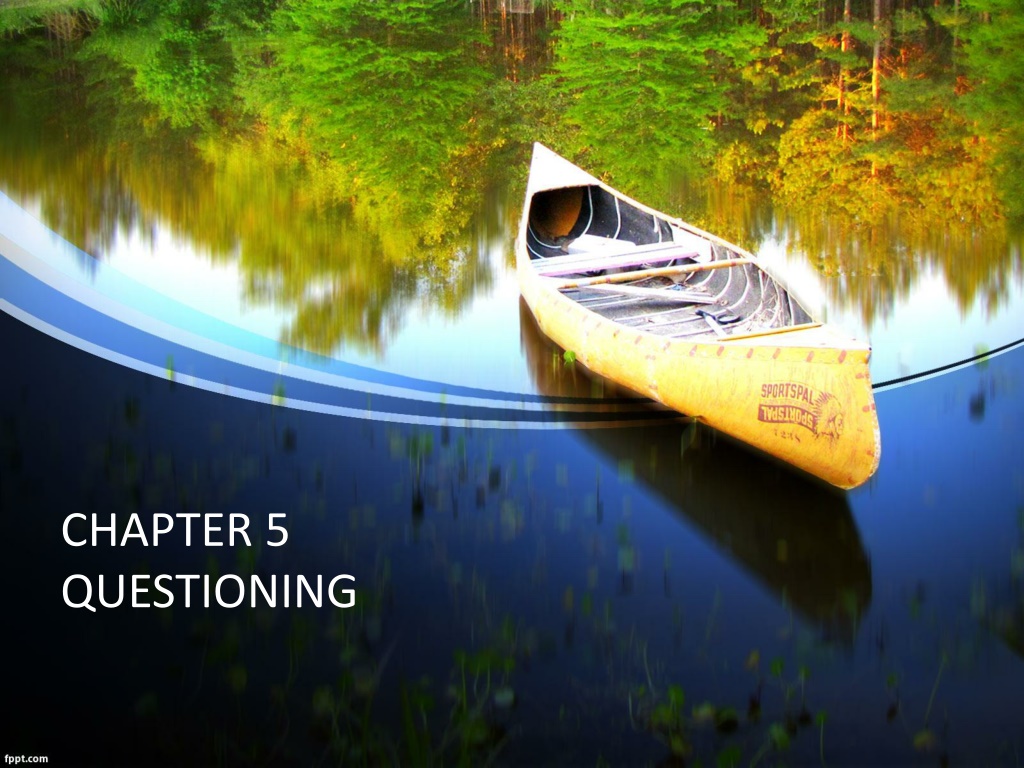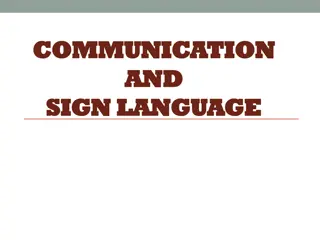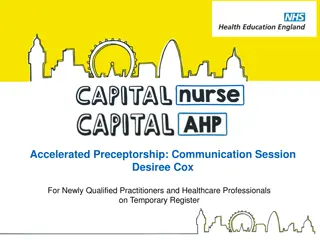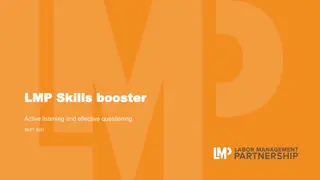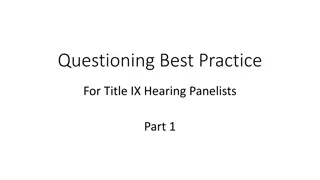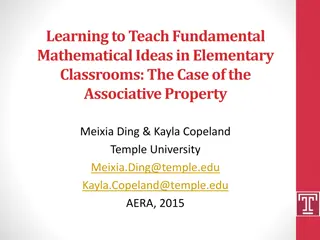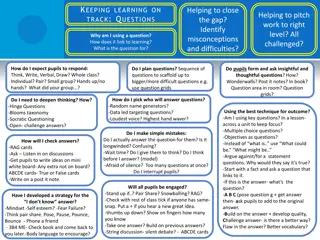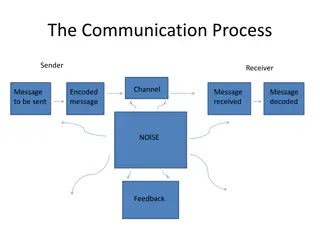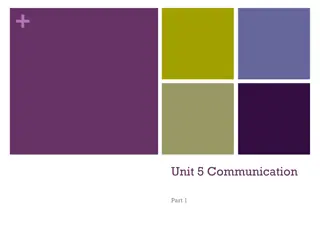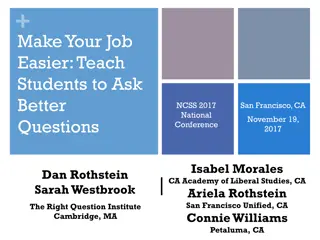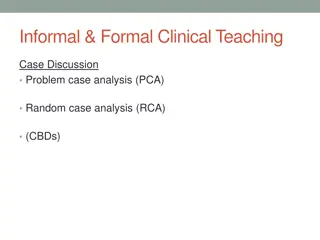Questioning: Key to Communication Success
Gathering information through questioning is a fundamental aspect of human interaction. Questions help us gain knowledge, solve problems, make decisions, and understand others better. Questioning plays a crucial role in successful communication, enabling us to express interest, maintain conversation control, and build rapport.
Uploaded on Feb 19, 2025 | 0 Views
Download Presentation

Please find below an Image/Link to download the presentation.
The content on the website is provided AS IS for your information and personal use only. It may not be sold, licensed, or shared on other websites without obtaining consent from the author.If you encounter any issues during the download, it is possible that the publisher has removed the file from their server.
You are allowed to download the files provided on this website for personal or commercial use, subject to the condition that they are used lawfully. All files are the property of their respective owners.
The content on the website is provided AS IS for your information and personal use only. It may not be sold, licensed, or shared on other websites without obtaining consent from the author.
E N D
Presentation Transcript
CHAPTER 5 QUESTIONING
Gathering information is a basic human activity we use information to learn, to help us solve problems, to aid our decision making processes and to understand each other more clearly.
Questioning is the key to gaining more information and without it interpersonal communications usually fail. Questioning is fundamental to successful communication and we all ask and are asked questions when engaged in conversation. We find questions and answers fascinating and entertaining politicians, reporters, celebrities and entrepreneurs are often successful based on their questioning skills asking the right questions at the right time and also answering (or not) appropriately.
Although questions are usually verbal in nature, they can also be non-verbal. Raising of the eyebrows could, for example, be asking, Are you sure? facial expressions can ask all sorts of subtle questions at different times and in different contexts. See our pages: Verbal Communication and Non-Verbal Communication for more.
examines verbal questioning. Why Ask Questions? Although the following list is not exhaustive it outlines the main reasons questions are asked in common situations.
To Obtain Information The primary function of a question is to gain information What time is it? To help maintain control of a conversation While you are asking questions you are in control of the conversation, assertive people are more likely to take control of conversations attempting to gain the information they need through questioning. (Also see our pages on Assertiveness)
Express an interest in the other person Questioning allows us to find out more about the respondent, this can be useful when attempting to build rapport and show empathy or to simply get to know the other person better. (Also see Building Rapport and Empathy)
Express an interest in the other person Questioning allows us to find out more about the respondent, this can be useful when attempting to build rapport and show empathy or to simply get to know the other person better. (Also see Building Rapport and Empathy)
To clarify a point Questions are commonly used in communication to clarify something that the speaker has said. Questions used as clarification are essential in reducing misunderstanding and therefore more effective communication.
To explore the personality and or difficulties the other person may have Questions are used to explore the feelings, beliefs, opinions, ideas and attitudes of the person being questioned. They can also be used to better understand problems that another person maybe experiencing like in the example of a doctor trying to diagnose a patient.
To test knowledge Questions are used in all sorts of quiz, test and exam situations to ascertain the knowledge of the respondent. What is the capital of France? for example.
To encourage further thought Questions may be used to encourage people think about something more deeply. Questions can be worded in such a way as to get the person to think about a topic in a new way. Why do you think Paris is the capital of France?
In group situations Questioning in group situations can be very useful for a number of reasons, to include all members of the group, to encourage more discussion of a point, to keep attention by asking questions without advance warning. These examples can be easily related to a classroom of school children.
How to Ask Questions Questioning is part of Verbal Communication Being an effective communicator has a lot to do with how questions are asked. Once the purpose of the question has been established you should ask yourself a number of questions:
What type of question should be asked See our page on question types. Is the question appropriate to the person/group? Is this the right time to ask the question? How do I expect the respondent will reply?
When actually asking questions especially in more formal settings some of the mechanics to take into account include: Being structured In certain situations, for example if you are conducting a research project or you work in a profession that requires the recording of information, it may be necessary to ask large numbers of questions. In such cases it is usually a good idea to inform the respondent of this before you start, by giving some background information and reasoning behind your motive of asking questions.
By doing this the respondent becomes more open to questions and why it is acceptable for you to be asking them. They also know and can accept the type of questions that are likely to come up, for example, In order to help you with your insurance claim it will be necessary for me to ask you about your car, your health and the circumstances that led up to the accident . In most cases the interaction between questioner and respondent will run more smoothly if there is some structure to the exchange.
Use silence Using silence is a powerful way of delivering questions. As with other interpersonal interactions pauses in speech can help to emphasize points and give all parties a few moments to gather their thoughts before continuing. A pause of at least three seconds before a question can help to emphasize the importance of what is being asked.
A three second pause directly after a question can also be advantageous; it can prevent the questioner from immediately asking another question and indicates to the respondent that a response is required. Pausing again after an initial response can encourage the respondent to continue with their answer in more detail. Pauses of less than three seconds have been proven to be less effective.
Encouraging participation In group situations leaders often want to involve as many people as possible in the discussion or debate. This can be at least partially achieved by asking questions of individual members of the group. One way that the benefits of this technique can be maximized is to redirect a question from an active member of the group to one who is less active or less inclined to answer without a direct opportunity.
Care should be taken in such situations as some people find speaking in group situations very stressful and can easily be made to feel uncomfortable, embarrassed or awkward. Encourage but do not force quieter members of the group to participate.
Types of Question Although there are numerous reasons for asking questions the information we receive back (the answer) will depend very much on the type of question we ask. In the simplest form there are two types of question, closed questions and open questions.
Closed Questions Closed questions invite a short focused answer- answers to closed questions can often (but not always) be either right or wrong. Closed questions are usually easy to answer - as the choice of answer is limited - they can be effectively used early in conversations to encourage participation and can be very useful in fact-finding scenarios such as research. The questioner using closed questions has a lot of control over the conversation, forcing brief - often one-word answers.
Closed questions can simply require a Yes or No answer, for example: Do you smoke? , Did you feed the cat? , Would you like a cup of tea? Closed questions can require that a choice is made from a list of possible options, for example: Would you like beef, chicken or the vegetarian option? , Did you travel by train or car today?
Closed questions can also be asked to identify a certain piece of information, again with a limited set of answers, for example: What is your name? , What time does the supermarket open? , Where did you go to University?
Open Questions By contrast to closed questions, open questions allow for much longer responses and therefore potentially more creativity and information. There are lots of different types of open question; some are more closed than others.
Leading or loaded questions A leading question, usually subtly, points the respondent s answer in a certain direction. Asking an employee, How are you getting on with the new finance system? This question prompts the person to question how they are managing with a new system at work.
In a very subtle way it raises the prospect that maybe they are not finding the new system so good. Tell me how you re getting on with the new finance system is a less leading question the question does not require any judgment to be made and therefore does not imply that there may be something wrong with the new system.
Recall and process questions Questions can also be categorized by whether they are recall requiring something to be remembered or recalled, or process requiring some deeper thought and/or analysis.
A simple recall question could be, What is your mother s maiden name? . This requires the respondent to recall some information from memory, a fact. A school teacher may ask recall questions of their pupils, What is the highest mountain? Process questions require more thought and analysis and/or a sharing of opinion. Examples include, What skills can you bring to this organization that the other applicants cannot? or What are the advantages and disadvantages of asking leading questions to children?
Rhetorical questions Rhetorical questions are often humorous and don t require an answer. If you set out to fail and then succeed have you failed or succeeded? Rhetorical questions are often used by speakers in presentations to get the audience to think questions promote thought.
Funneling We can use clever questioning to essentially funnel the respondent s answers that is ask a series of questions that become more(or less) restrictive at each step, starting with open questions and ending with closed questions or vice-versa. For example: "Tell me about your most recent holiday." "What did you see while you were there?" "Were there any good restaurants?" "Did you try some local delicacies?" "Did you try Clam Chowder?"
The questions in this example become more restrictive, starting with open questions which allow for very broad answers, at each step the questions become more focused and the answers become more restrictive. Funneling can work the other way around, starting with closed questions and working up to more open questions.
Responses As there are a myriad of questions and question types so there must also be a myriad of possible responses. Theorists have tried to define the types of responses that people may have to questions, the main and most important ones are: A direct and honest response this is what the questioner would usually want to achieve from asking their question.
Responses As there are a myriad of questions and question types so there must also be a myriad of possible responses. Theorists have tried to define the types of responses that people may have to questions, the main and most important ones are: A direct and honest response this is what the questioner would usually want to achieve from asking their question.
A lie the respondent may lie in response to a question. The questioner may be able to pick up on a lie based on plausibility of the answer but also on the non-verbal communication that was used immediately before, during and after the answer is given. Out of context The respondent may say something that is totally unconnected or irrelevant to the question or attempt to change the topic. It may be appropriate to reword a question in these cases.
Partially Answering People can often be selective about which questions or parts of questions they wish to answer. Avoiding the answer Politicians are especially well known for this trait. When asked a difficult question which probably has an answer that would be negative to the politician or their political party, avoidance can be a useful tact. Answering a question with a question or trying to draw attention to some positive aspect of the topic are methods of avoidance.
Stalling Although similar to avoiding answering a question, stalling can be used when more time is needed to formulate an acceptable answer. One way to do this is to answer the question with another question.
Distortion People can give distorted answers to questions based on their perceptions of social norms, stereotypes and other forms of bias. Different from lying, respondents may not realize their answers are influenced by bias or they exaggerate in some way to come across as more normal or successful. People often exaggerate about their salaries. Refusal The respondent may simply refuse to answer, either by remaining silent or by saying, I am not answering .
